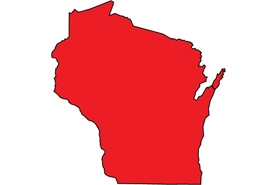Diffuse knapweed
(Centaurea diffusa)
Short-lived perennial, annual, or monocarpic perennial knapweed with a long fibrous taproot and single upright stem covered in fine hairs. Plants form dense colonies and readily reproduce by seeds, which can travel long distances.
Other names for this plant include:
- Common names: tumble knapweed, spreading knapweed, white knapweed
- Scientific names: Acosta diffusa
Classification in Wisconsin: Prohibited
- Ecological Threat
-
- Invades open grasslands, prairies, open forests, orchards and disturbed areas such as ditches, cultivated fields and field edges. Also commonly found near water sources such as river bottoms and irrigated areas.
- Aggressively outcompetes native vegetation, reducing overall biodiversity.
- Seeds readily disperse across long distances, enhanced by human activity.
- Reduces forage quality for wildlife and livestock due to its prickly spines, fibrous foliage and bitter flavor.
- Plants are allelopathic, producing toxic chemicals that inhibit desired plant growth.
- Identification
-
Leaves & stems: Single upright stem with many branches, up to 40" tall. Plants have a gray appearance due to tiny fine hairs. Leaves are finely divided and alternate. Stems easily break at the ground level, resulting in increased seed dispersal.
Flowers: Flowers are usually white, sometimes pinkish to purple and form at the tip of branches. Bracts contain numerous lateral spines and one prominent terminal spine. They do not have a pappus (parachute-like structure that aids in seed dispersal).
Fruits & seeds: Seed heads are urn-shaped, with many seeds compact in the flower head. The nodding flower head gives the plant its mobility, turning into a "tumbleweed" when flowering stalks break off facilitating seed transport over long distances. Plants produce on average over a thousand seeds per plant.
Roots: Long fibrous taproots.
Similar species: Diffuse knapweed can be distinguished from spotted knapweed by their bracts. Bracts on diffuse knapweed may have darker coloration on the tips but lack the fringe on spotted knapweed. Furthermore, diffuse knapweed bracts have rigid terminal and lateral spines. Russian knapweed bracts have light thin hairs. Visit the Resources tab for more information.
- Control
-
In many cases, a combination of treatment regimes is the most effective approach to control. Because diffuse knapweed contains allelopathic compounds, plant debris must be removed from the site to facilitate revegetation. Reseeding with desired vegetation is critical to increasing treatment efficacy.
Mechanical:- For smaller populations, persistent hand-pulling of plants can be effective. Pull as much taproot as possible (most accessible in moist soils). Flowering plants should be bagged and disposed of.
- Mowing during the flowering stage effectively prevents seed production and reduces overall density after multiple years.
- Tilling at a depth of 7 inches followed by dense reseeding of desired species can help prevent reinvasion. *Be sure you have identified species correctly! Similar-looking Russian knapweed increases under cultivation practices since plants spread via rhizomes fragments.
- Burning alone is not as effective as it stimulates new growth; follow up with herbicide treatment.
- Herbicide treatments are most effective when combined with other control techniques and followed by reseeding. The timing of herbicide treatments is essential to effectiveness.
- Mow during the flowering stage followed by herbicide application of clopyralid + 2,4D at 1 quart/acre is recommended. Visit this Montana State University Publication [PDF, exit DNR] for specific herbicide applications.
- Resources
- Sources for content:
- Knapweeds (Spotted, Diffuse, & Russian) - Noxious Weed Integrated Vegetation Management Guide, IPM Practitioners Association.
- Montana State University Extension: Biology, Ecology, and Management of Montana Knapweeds; Knapweed Identification Monthly Weed Report, 2011.
- Center for Invasive Species and Ecosystem Health; Invasive.org


